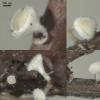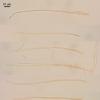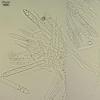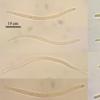
03-11-2025 21:34
 Edvin Johannesen
Edvin Johannesen
These tiny (0.4-0.5 mm diam.), whitish, short-stip

28-10-2025 15:37
Carl FarmerI'd be grateful for any suggestions for this strik

03-11-2025 16:30
 Hans-Otto Baral
Hans-Otto Baral
Hello I want to ask you if you have found this ye

28-10-2025 19:33
 Nicolas Suberbielle
Nicolas Suberbielle
Bonjour à tous,Je voudrais votre avis sur cette r

31-10-2025 09:19
 Lothar Krieglsteiner
Lothar Krieglsteiner
Can somebody provide me with a file of:Rogerson CT

09-08-2025 13:13
 Maria Plekkenpol
Maria Plekkenpol
Hello,Yesterday I found these on burnt soil. Apoth
This species quite often met at dead twigs of dwarfshrubs (Chamaedaphne calyculata, but probably others as well), in bogs. I have only one collection, though. It was without clamps; this feature reported by Raitviir (2002, A revision of the genus Dasyscyphella?) "for all Eurasian collections", but "in American collections they originate from croziers" (var. uncinata Raitv.).
All characters fit well with description of D. cassandrae var. cassandrae, except spore septation. I see clear septa already inside the asci; but Raitviir described them aseptate.
I think, what i 've seen it is real septation? -and if so, it must be underdescribed character of this species?
Apothecia cupulate, stipitate, receptacle to 1 mm in diam, stipe to 1 mm high, all frb up to 1,5 mm; hymenium yellowish, outer sirface pure white; outer surface and stipe densely covered by hairs; edge with long hairs; growing scattered or by several nearby.
Excipulum from textura porrecta in stipe (hyphae near 4 mk broad), textura prismatica at flanks (cells ellipsoid, with thickened walls, 20-30 x 6-8; hairs cylindrical, up to 150 mk long, rough at base, smooth in upper part, 4-6 segmented, the base slightly broader (3) and tip slightly enlarged, the narrowest part under tip beeing near 2; asci clavate, tip obtuse-conical, sometimes with protruding pore site, without clamp, pore euamyloid, with 8 interwoven spores collected in upper part, 92,5 (80-116) x 10 (8-11); paraphyses cylindrical, scarsely branched, segmented, with vacuolar content (vital, water); 2 mk broad, not exceeding the asci; spores vermiform, curled in asci, without or with 3-5 septa (already inside asci), 52 (44-67) x 2,4 (2-2,6) (N=14) (real length some longer since measurements done in curved state).
Au sujet du cloisonnement des spores, lire la diagnose originale reproduite dans la revue Hedwigia 1899 (38) : 10
http://www.biodiversitylibrary.org/page/507326
"... deutlicht septirt, zuweilen auch dreizellig, ..."
Amitiés, Guy
DENNIS R.W.G. 1972 The type species of Dasyscyphella Tranzschel. [cassandrae, corticola]. Kew Bull. 27 2 273-274.
Si vous n'avez pas cet article, je peux faire une copie ce soir.
So, in the original description by Tranzscel spores "filiform, usually curved, sickle-shaped, in the middle clearly septate, sometimes 3-celled, hyaline". This matches my observations well (mine up to 5-celled). For some reason Raitviir has omitted this character in two his works on the genus (1970, 2002).?









